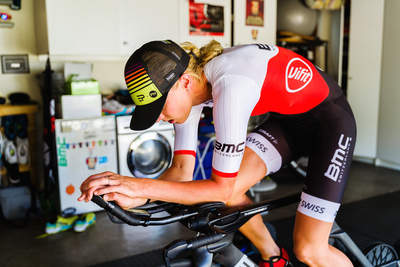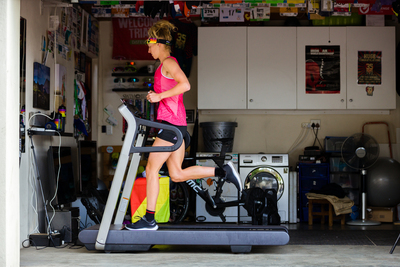In 1986, a German medical engineering student by the name of Uli Schoberer created a very agricultural looking bicycle crank. I wonder if he realised then that his creation would completely reshape how we train as athletes today...
The rise of the power meter
Schoberer’s new company at the time, SRM, subsequently launched its first commercial power meter a handful of years later and was further popularised when American cyclist Greg Lemond apparently used one for his training to help prepare for the Tour de France.
I bought my first power meter, albeit with slightly less success than Greg, back in 2006. It was from a now defunct company that measured power within a bicycle’s bottom bracket, took what you produced with one leg and then doubled it to tell you how much you were putting out overall.
When you consider that the human body isn’t symmetrical, I had no clue that my power meter was probably a random bingo number calling machine... but it was a game-changer for me at the time.

Power meters in sport are broadly associated with cycling but are also commercially available for runners, swimmers, kayakers and rowers too. Power output (measured in Watts) is a pretty blunt and stark statement about what you’re physically producing.
Whether you’re going uphill, downhill, into a headwind or enjoying a tailwind, it’s the best way to set careful and measurable targets. As a result, it’s become a very popular and powerful tool with athletes for their training and racing. But its effective use requires knowledge and analysis and, as a result, it’s not without its issues, limitations and misunderstandings.
The problem with power meters
The problem with power meters is that some people rely on them so much and are influenced by what they’re saying, that they lose sight of the fact that we're human beings, not machines.
For example, there were suggestions of Tour de France winner Chris Froome staring downwards at his power meter display, calculating exactly how hard and how long he should ride for. Such antics attracted a lot of criticism in the press that pro cycling was being sanitised and subsequent calls arose for them to be banned.
However, the bigger problem in my view isn't the impact of the humble watt in racing but its impact on the athletes' psyche itself.
In effect, power outputs and thresholds can become a bit of a glass ceiling to athletes when not used correctly. I’ve been in this situation myself. On occasion, I became afraid to push beyond what my power meter said for fear of exploding into a mushroom cloud of carbon fibre and lactic acid.
Interestingly, I’ve also spoken to other athletes reluctant to deviate from what their power meter was telling them in races. They were unwilling to gamble or were worried about failure.
In an extreme scenario, an investigation into the T-RST supersonic fighter that subsequently crashed revealed that there had been an over-reliance on its protection technology. The researcher noted that we should “consider the implications of wresting control away from the pilot and giving it to the computer”. It doesn’t take a huge leap of faith to see the similarities with what some athletes do with power meters.

Therefore, if we allow glass ceilings such as wattage govern what we’re doing, you may never realise your true potential or have the ability to be flexible in your decision-making. Coincidentally, the management of the Italian Vini Zabù-KTM cycling team banned its riders from using power meters during races in 2020. The concern was that some of their riders had become so obsessed with the numbers that it was holding them back from making in-race tactical judgements. I know I can struggle to choose what flavour recovery shake to have some days but this was not what power meters were intended to do.
Are you suffering from technostress?
In some cases, the impact of technology on us can be so severe it can actually affect our wellbeing. Whilst the actual research in this area with respect to competitive sport is limited, in the broader sense, issues surrounding technological reliance, dominance or stress have all seen a very recent and rapid surge in attention.
A lot of this is with respect to smartphone use or social media but you can see the parallels with sport. For example, consider the impact of ‘technostress’.
Technostress has been defined as “any negative impact on attitudes, thoughts, behaviour or physiology that is caused either directly or indirectly by technology” or “a modern disease of adaptation caused by the inability to cope with new technologies in a healthy manner”.
Have you ever been frustrated, upset or angry when you’ve looked at your power meter mid-ride or its data afterwards? That is, in essence, a degree of technostress. In extreme cases, this can lead to anxiety and even addiction.
Instead, Riva et al. noted that what should be happening with our use of such tools is “the scientific and applied approach to the use of technology for improving the quality of our personal experience”. Therefore, power meters should be used as a tool and not as your boss (after all, nobody likes their boss).
Renowned exercise physiologist Dr Andy Coggan (arguably one of the fathers of modern-day power training methods) once said it's crucial to train with power and not by power.
It shouldn't be a rod up one’s own back. This is particularly pertinent to athletes because power meters aren't an artificial intelligence driven system and it’s not infallible. In other words, they can’t tell you what to do and if you haven't tested yourself in a while or had your meter regularly calibrated or serviced, there’s a fair chance that there will be some degree of error in the numbers too. This can be known as GIGO or ‘garbage in, garbage out’. Therefore, it’s imperative to keep your data management up to date but also listen to your internal dialogue and how you’re feeling when you train.
Do you need a power meter?
Leading on from this, could we actually be better without power meters at all?
Removing your meter or just covering the screen can be a powerful way to know how to manage our recovery or relearn what a particular pace feels like. For example, mountain biking legend Ned Overend has stated on multiple occasions that with respect to his training - “I base it on feel a lot” and “I’m great at perceived effort training.” He pushes hard when he feels he’s ready to, but backs off if his legs haven’t shown up for the occasion. He’s now lasted six decades in elite-level sport.
Likewise, Chloe Dygert won the Time Trial World Championships in 2019 with no power meter at all, having later said that it was an advantage to do so.

As a scientist, I’d say that such successes could equally be in spite of the absence of a power meter, not because of it. However, what’s really interesting here is that these athletes were both happy and successful as a result. That in itself speaks volumes. Clearly I need to be less Terminator, more Jedi.
Ultimately then, my advice is that athletes training with power should do so with clear, measurable targets but remain sensitive to adjustment based on how they feel at that time. In training, use them to keep your sessions defined and honest but stretch yourself occasionally.
When you race, use it to prevent going too hard or too soon but remain aware of what is happening in the environment around you as the event unfolds. If you’re going ok, your body feels good and you still feel like you’ve got more to give, drop the hammer and see what happens. You may well surprise yourself.
